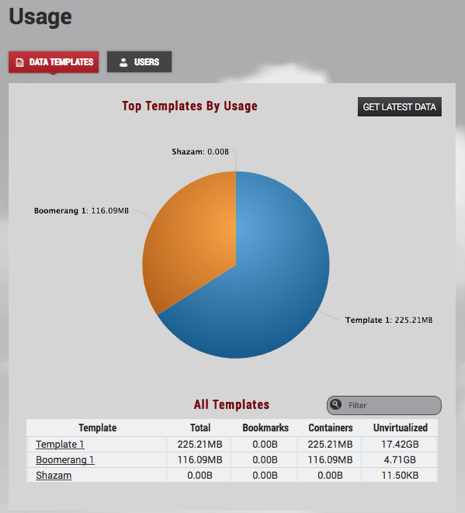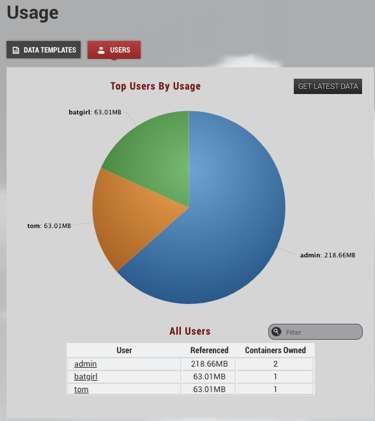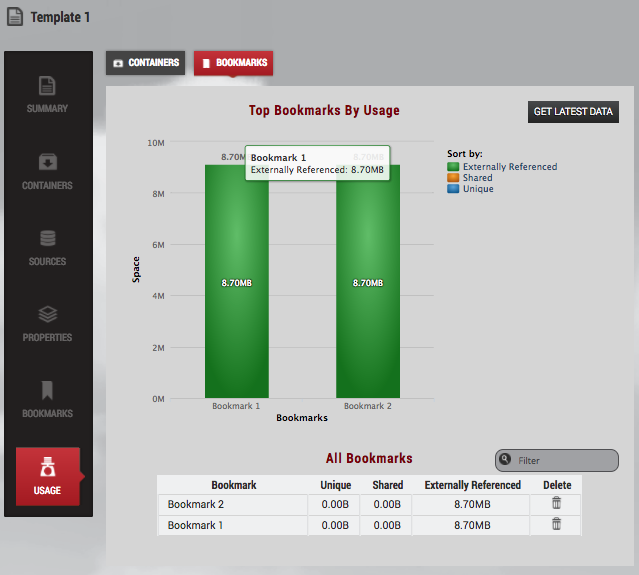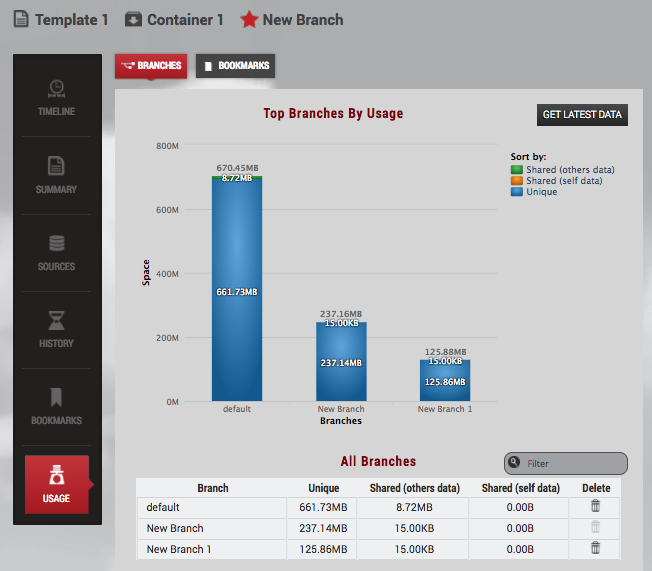Understanding Delphix self-service usage management
Usage management dashboard overview
Data templates are comprised of dSources, virtual databases (VDBs), and vFiles. These data sources are controlled by the standard policies configured in the Management application of the Delphix Engine. As with existing containers, space will be reclaimed by the retention policy over time. As retention cleans up historical data, users will no longer be able to use those points in time to restore or branch. In Delphix Self-Service, an admin can create a bookmark on the data template timeline, which will prevent retention from cleaning up the data that a bookmark references.
Data containers are comprised of VDBs provisioned from the sources defined in the data template. Similar to VDBs in the Management application, data containers' VDBs will share blocks with the source from which they are provisioned. This prevents the referenced data on the source from being cleaned up by retention. Retention for these VDBs is controlled by the standard Delphix Engine retention policies. As on templates, bookmarks in data containers will prevent storage from being reclaimed by retention. In addition, Self-Service will ensure that the latest data on each branch is never removed.
The Usage pages of the data templates and data containers provide information that can help you understand how storage is being used, how to reclaim space, and how much space you are able to reclaim.
Usage Overview is a top-level page, along with the Data Operations and Overview pages. It contains the space usage breakdowns by data templates and users.

Template usage overview
The Template Usage page, seen in the image below, contains the usage breakdowns for data templates and users. The interface is interactive and allows you to visualize data by interacting with pie charts, bar graphs, and tables. The pie chart contains information about the top 10 space consumers; the table at the bottom contains information about all of the templates and/or users.
The table below the charts includes category fields. You can find corresponding descriptions by hovering over the names of the fields in the table:

The Template Usage page
Additionally, the table allows you to sort, navigate, and interact by clicking the field category of interest. For example, to sort the table, click a column header such as Unvirtualized and the table will sort by that category. To navigate to a particular data template or user, you can click either the pie slice or the name of the template/user in the table.

Table of templates/users
The field categories display the following information:
Total – The sum of the space used by the data containers provisioned from this data template and by the bookmarks created on this template. This is the space that will be freed if you delete the template.
Containers – The amount of space used by the data containers provisioned from this data template. This is the space that will be freed if you delete or purge all of the data containers.
Bookmarks – The amount of space used by the bookmarks on this data template. This is the space that will be freed if you delete all bookmarks on the template.
Unvirtualized – The amount of space that would be used by the data in this template and its child data containers without Continuous Data.
The pie chart and table graphs can help you analyze storage usage information.
Template usage details
The Usage tile appears at the bottom of the Self-Service navigation sidebar, as seen in the image below. Usage summaries are available for templates, containers, and users. For example, when you click the Usage tile on the Template Details page, the usage details you interact with will be in the context of the selected data template.

The Usage tile
User usage overview
The User Usage Overview page provides graphical visualizations of space used by users assigned to data containers.

The field categories display the following information:
Referenced – The amount of space used by data containers that are owned by this user. This excludes the space that this user is sharing with other users.
Containers Owned – The number of data containers owned by this user
Template usage (Containers) overview
The Template Usage Details page, as seen below, shows the space used by data containers provisioned from the template and the bookmarks created on the template.

Container Usage
The stacked bar graph shows information about the top 10 space users. You can re-sort the graph based on the fields in the Sort by the legend on the top right-hand corner of the screen as seen in the image above. For example, if you want to know which data containers are sharing the most data with others, you can un-select Shared (others data) and Unique by clicking them in the legend.

The Sort by legend
Legend Items When the legend items are not selected, their corresponding colored boxes turn gray and the data is removed from the chart. The data and name will reappear when you re-select by clicking the grayed-out category you want.
The field categories display the following information:
Unique – The amount of space that will be freed if you delete this data container. This assumes that it also deletes underlying data sources.
Shared (others data) – The amount of space that cannot be freed on the parent data template (or sibling data containers) because it is also being referenced by this data container due to Restore or Create Branch operations. The snapshots on the template or sibling container are what use up space.
Shared (self data) – The amount of space that cannot be freed on this data container because it is also being referenced by sibling data containers due to Restore or Create Branch operations, via shared bookmarks
Unvirtualized – The amount of space that would be used by the data in this container without Continuous Data
Template usage (Bookmarks) overview
As shown in the image below, the Template Usage Details page provides the usage information about bookmarks created on a template. The primary categories of information include Unique, Shared (others data) and Shared (self data).

Template Usage (Bookmarks)
The field categories display the following information:
Unique – The amount of space that will be freed if you delete this bookmark
Shared – The amount of space referenced by this bookmark that cannot be freed by deleting this bookmark because it is also referenced by neighboring bookmarks or branches that have been created or restored from this bookmark
Externally Referenced – The amount of space referenced by this bookmark that cannot be freed by deleting this bookmark because it is also being referenced outside of Self-Service – for example, by a retention policy.
Container usage (Branches) overview
The Container Usage Details page shows the usage information about the branches and bookmarks created on a container. The primary categories of information include Unique, Shared (others data), and Shared (self data).

The Container Usage Details page
The field categories display the following information:
Unique – The amount of space that will be freed if you delete this branch
Shared (others data) – The amount of space that cannot be freed on the parent data template or sibling branches because it is also being referenced by this branch due to Restore or Create Branch operations. The snapshots on the template or sibling container are what use up space.
Shared (self data) – The amount of space that cannot be freed on this branch because it is also being referenced by sibling data containers due to Restore or Create Branch operations, via shared bookmarks.
